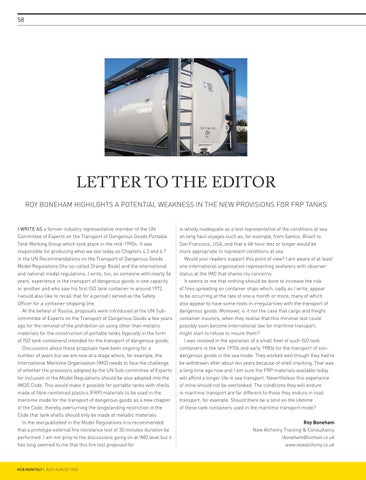58
LETTER TO THE EDITOR ROY BONEHAM HIGHILGHTS A POTENTIAL WEAKNESS IN THE NEW PROVISIONS FOR FRP TANKS I WRITE AS a former industry representative member of the UN Committee of Experts on the Transport of Dangerous Goods Portable Tank Working Group which took place in the mid-1990s. It was responsible for producing what we see today as Chapters 4.2 and 6.7 in the UN Recommendations on the Transport of Dangerous Goods Model Regulations (the so-called Orange Book) and the international and national modal regulations. I write, too, as someone with nearly 54 years’ experience in the transport of dangerous goods in one capacity or another and who saw his first ISO tank container in around 1972. I would also like to recall that for a period I served as the Safety Officer for a container shipping line. At the behest of Russia, proposals were introduced at the UN Subcommittee of Experts on the Transport of Dangerous Goods a few years ago for the removal of the prohibition on using other than metallic materials for the construction of portable tanks (typically in the form of ISO tank containers) intended for the transport of dangerous goods. Discussions about these proposals have been ongoing for a number of years but we are now at a stage where, for example, the International Maritime Organisation (IMO) needs to face the challenge of whether the provisions adopted by the UN Sub-committee of Experts for inclusion in the Model Regulations should be also adopted into the IMDG Code. This would make it possible for portable tanks with shells made of fibre-reinforced plastics (FRP) materials to be used in the
is wholly inadequate as a test representative of the conditions at sea on long haul voyages such as, for example, from Santos, Brazil to San Francisco, USA, and that a 48-hour test or longer would be more appropriate to represent conditions at sea. Would your readers support this point of view? I am aware of at least one international organisation representing seafarers with observer status at the IMO that shares my concerns. It seems to me that nothing should be done to increase the risk of fires spreading on container ships which, sadly as I write, appear to be occurring at the rate of one a month or more, many of which also appear to have some roots in irregularities with the transport of dangerous goods. Moreover, is it not the case that cargo and freight container insurers, when they realise that this minimal test could possibly soon become international law for maritime transport, might start to refuse to insure them? I was involved in the operation of a small fleet of such ISO tank containers in the late 1970s and early 1980s for the transport of nondangerous goods in the sea mode. They worked well though they had to be withdrawn after about ten years because of shell cracking. That was a long time ago now and I am sure the FRP materials available today will afford a longer life in sea transport. Nevertheless this experience of mine should not be overlooked. The conditions they will endure in maritime transport are far different to those they endure in road
maritime mode for the transport of dangerous goods as a new chapter of the Code, thereby overturning the longstanding restriction in the Code that tank shells should only be made of metallic materials. In the text published in the Model Regulations it is recommended that a prototype external fire resistance test of 30 minutes duration be performed. I am not privy to the discussions going on at IMO level but it has long seemed to me that this fire test proposed for
transport, for example. Should there be a limit on the lifetime of these tank containers used in the maritime transport mode?
HCB MONTHLY | JULY-AUGUST 2022
Roy Boneham New Alchemy Training & Consultancy rboneham@hotmail.co.uk www.newalchemy.co.uk































